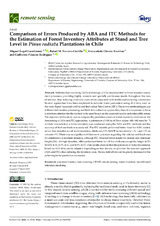Comparison of Errors Produced by ABA and ITC Methods for the Estimation of Forest Inventory Attributes at Stand and Tree Level in Pinus radiata Plantations in Chile
Autor
Lara-Gómez, Miguel
Navarro Cerrillo, Rafael M.
Clavero Rumbao, Inmaculada
Palacios Rodríguez, Guillermo
Editor
MDPIFecha
2023Materia
Precision forestryLaser scanning
LiDAR
Remote sensing
Forest inventory
Model-based inference
Modeling
METS:
Mostrar el registro METSPREMIS:
Mostrar el registro PREMISMetadatos
Mostrar el registro completo del ítemResumen
Airborne laser scanning (ALS) technology is fully implemented in forest resource assessment processes, providing highly accurate and spatially continuous results throughout the area of interest, thus reducing inventory costs when compared with traditional sampling inventories. Several approaches have been employed to estimate forest parameters using ALS data, such as the Area-Based Approach (ABA) and Individual Tree Crown (ITC). These two methodologies use different information processing and field data collection approaches; thus, it is important to have a selection criterion for the method to be used based on the expected results and admissible errors. The objective of this study was to compare the prediction errors of forest inventory attributes in the functioning of ABA and ITC approaches. A plantation of 500 ha of Pinus radiata (400–600 trees ha−1) in Chile was selected; a forest inventory was conducted using the ABA and ITC methods and the accuracy of both methods was analyzed. The ITC models performed better than the ABA models at low tree densities for all forest inventory attributes (15% MAPE in tree density—N—and 11% in volume—V). There was no significant difference in precision regarding the volume and basal area (G) estimations at medium densities, although ITC obtained better results for density and dominant height (Ho). At high densities, ABA performed better for all the attributes except for height (6.5% MAPE in N, 8.7% in G, and 8.9% in V). Our results showed that the precision of forest inventories based on ALS data can be adjusted depending on tree density to optimize the selected approach (ABA and ITC), thus reducing the inventory costs. Hence, field efforts can be greatly decreased while achieving better prediction accuracies.

